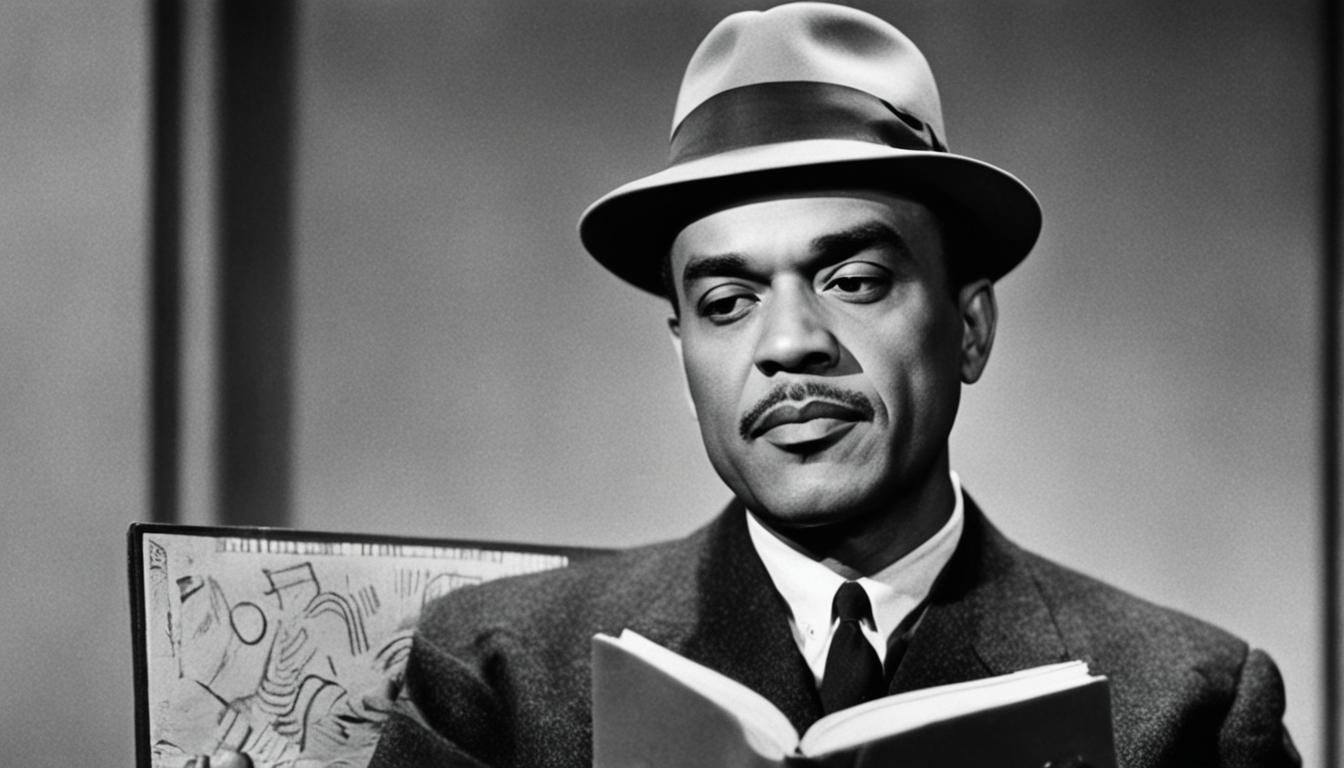“Invisible Man” is a landmark novel by American author Ralph Ellison, first published in 1952. Considered a classic of African American literature, the novel explores themes of identity, invisibility, and power dynamics through the experiences of the unnamed narrator.
Set against the backdrop of mid-20th century America, “Invisible Man” offers a powerful commentary on the social and racial issues of its time, while also reflecting the broader human experience of searching for meaning and self-understanding.
In this article, we will take a closer look at the significance of “Invisible Man” in American literature, examining its historical and social context, major themes and motifs, characters, literary techniques, critical reception, adaptations, and contemporary relevance. We will also provide an audiobook review of “Invisible Man,” offering valuable insights into the production and narration of this modern classic.
Join us on this journey of analysis and interpretation as we delve deep into the pages of Ralph Ellison’s groundbreaking 1952 novel.
Background and Context
Ralph Ellison, one of the most celebrated African American writers of the 20th century, was heavily influenced by the literary traditions of his community. He was a part of the Harlem Renaissance movement, a cultural revolution in the 1920s and 1930s that gave rise to a new wave of Black art, music, and literature. Ellison’s work, including his seminal novel Invisible Man, draws heavily from the complex legacy of the Harlem Renaissance.
The Harlem Renaissance was characterized by a profound sense of Black pride and a desire to reclaim and celebrate African American culture. The movement produced notable writers, such as Langston Hughes, Zora Neale Hurston, and Countee Cullen, who explored the social, political, and cultural experiences of Black Americans. Ellison’s work is deeply rooted in this tradition, as he grapples with issues of racial identity, inequality, and the struggle for self-expression.
“I am invisible, understand, simply because people refuse to see me.” – Ralph Ellison, Invisible Man
Ellison’s upbringing in the South, where he experienced first-hand the realities of Jim Crow segregation, also serves as a significant backdrop to his work. He moved to Harlem in the 1930s, where he found community among fellow writers and intellectuals, and began to develop his unique voice and approach to storytelling. His experiences in Harlem, coupled with his deep understanding of African American literature, laid the foundation for his iconic novel, Invisible Man.
Plot Summary
Invisible Man is a powerful novel by Ralph Ellison that explores the experiences of an unnamed African American narrator who grows up in the South before moving to Harlem. The narrator is forced to confront the pervasive racism and discrimination of society, which renders him invisible, without an identity of his own. The novel follows his journey towards self-discovery and understanding his place in society, as he encounters a range of characters who both challenge and reinforce his beliefs.
The protagonist experiences a series of traumatic events that shape his identity, including being expelled from college for an innocent mistake and working as a participant in a bizarre, degrading battle royal. Through his experiences, the protagonist begins to understand the deeper social dynamics that underpin the oppression of African American people and grapples with his own role in that system.
The narrator is eventually drawn into the Brotherhood, a fictional organization that seeks to promote equality and justice for African Americans. Through his involvement with the group, he becomes disillusioned by the limitations of their activism and the ways in which power dynamics operate within their ranks. As the novel progresses, the protagonist becomes increasingly isolated from the Brotherhood and society at large, culminating in a powerful and emotional confrontation that brings the themes of the narrative to the forefront in a memorable and thought-provoking way.
Themes and Motifs
One of the most significant aspects of “Invisible Man” is its exploration of major themes and motifs that contribute to the novel’s profound impact on its readers.
Throughout the narrative, the concept of identity is a prevailing theme that resonates with readers. The protagonist’s struggle to define his identity amidst racial discrimination and societal expectations highlights the complex nature of individual identity formation.
Another central theme is the idea of invisibility, both literally and figuratively. The protagonist’s invisibility as a Black man and the societal erasure of marginalized groups metaphorically underscore the novel’s exploration of the power dynamics that exist within society.
The novel also delves into the interplay between power and identity, illuminating the way in which cultural and historical forces shape individual and collective identities.
Finally, the theme of racial discrimination and the pernicious effects of racism are explored in-depth throughout the narrative, drawing attention to the systemic and pervasive nature of racism within American society.
Motifs
Symbolism is employed throughout “Invisible Man,” with key motifs reinforcing the novel’s themes and adding depth to the characters and their experiences.
| Motif | Description |
|---|---|
| Light | Represents knowledge and insight, as well as the protagonist’s search for clarity in his identity |
| The Sambo Doll | Symbolizes the caricatured images of Black people propagated by white American culture |
| The Liberty Paints Plant | Represents the way in which Blackness is commodified and exploited by those in power |
These motifs contribute to the novel’s layered and complex exploration of identity, power, and race, solidifying “Invisible Man” as a seminal work in American literature.
Character Analysis
Throughout “Invisible Man,” Ralph Ellison creates complex and multifaceted characters that reflect the social and political issues of mid-20th century America.
The protagonist, Invisible Man, is a young African American man who grapples with his identity as he navigates the racial tensions and power dynamics of society. His journey of self-discovery is shaped by encounters with a range of characters, including the manipulative and powerful Brother Jack, the idealistic and passionate Brotherhood members, and the tragic Trueblood, whose experiences highlight the devastating legacy of slavery in America.

One of the most compelling characters in the novel is Ras the Exhorter, an enigmatic figure who embodies the struggle for Black liberation and self-determination. His confrontations with Invisible Man foreshadow the violent conflicts that erupt as the Civil Rights movement gains momentum.
“You’re a traitor to your race,” Ras said. “We mean to smash what you represent, man, and what you represent is a sham. You are a walking acorn, yellow on the outside and white inside, hollow to the core. The Brotherhood seeks to bring about social change, but this change will only benefit the white power structure. This is not true revolution.”
Ellison’s vivid and detailed characterizations provide a powerful lens through which to understand the complex historical and social issues of the novel. By examining the motivations, flaws, and relationships of each character, readers gain insight into the broader themes of identity, power, and social justice that Ellison explores in “Invisible Man.”
Writing Style and Literary Techniques
In “Invisible Man,” Ralph Ellison employs a unique writing style that blends elements of realism and surrealism. His prose is often described as poetic, with vivid and evocative language that immerses readers in the story. Ellison is skilled at using symbolism and imagery to convey deeper meanings and explore complex themes such as identity, power dynamics, and racial discrimination. For instance, the repeated motif of invisibility serves as a metaphor for the protagonist’s struggle to find his place in a society that sees him as less than human.
Ellison’s use of narrative structure is also noteworthy. He employs a non-linear structure, jumping back and forth in time to reveal different aspects of the protagonist’s journey. This approach creates a sense of layering, with each new revelation expanding our understanding of the story and its characters.
“For the quality of the writing, I would recommend this book to anyone interested in literary techniques.” – Reader Review
Historical and Social Significance
As a reflection of mid-20th century America, “Invisible Man” holds significant historical and social relevance. Ralph Ellison’s novel provides a poignant commentary on the racial dynamics of the era, delving into the complexities of identity, visibility, and power struggle.
The story of the protagonist, an unnamed black man, who navigates his way through a society that consistently undermines and dehumanizes him is a stark portrayal of the systemic racism that had proliferated in America at the time. The character’s invisibility forces readers to confront the ways in which society actively denies the humanity of black individuals.
“Invisible Man” serves as a reminder of the historical injustices faced by African Americans. Ellison’s novel illuminates the ways in which societal systems and power structures perpetuate racism, making it difficult for marginalized individuals to succeed.
The historical significance of “Invisible Man” lies in its ability to provide a window into the past, underscoring the deeply-rooted nature of the social and racial issues faced by individuals at the time. It is a poignant commentary on the experiences of marginalized people, relevant not just in the mid-20th century, but in contemporary society.
Critical Reception
“Invisible Man” garnered critical acclaim upon its publication, cementing Ralph Ellison’s place as a significant voice in American literature.
The novel won the National Book Award for Fiction in 1953, with the judges lauding it as a “masterpiece” that “combines extraordinary richness of texture with absolute clarity of meaning.”
“‘Invisible Man’ is a book of such great importance, a book filled with anger and compassion, complexity and deep-laid honesty, that it deserves much more than one reading. … This is a book that speaks to the confusion of existence in a modern society, but it does not preach, it does not dictate, it does not contain easy answers. Its beauty is that it remains poised between opposite vectors without ever sacrificing one for the other.”
The New York Times Book Review
“Ellison’s powerful and poignant masterpiece, the definitive chronicle of contemporary black American experience…Irreverent, ironic, harsh, and yet surprisingly sentimental, ‘Invisible Man’ is a passionate and uncompromising, and yet ultimately prudent and circumspect, novel of innocence and experience, of the vagaries of memory and the mystery of identity, of the promises and betrayals of democracy and the inescapable return of repressed racial violence.”
Booklist
Since its publication, “Invisible Man” has been studied and celebrated for its incisive commentary on race and identity in America and its masterful use of language and symbolism. It remains a powerful and enduring work of literature today.
Adaptations and Influence
Since its publication, “Invisible Man” has been adapted into various forms of media, with each adaptation bringing something new to the table. The most notable adaptation is the 1964 film directed by field_546bc5a674714, which, despite several deviations from the source material, manages to capture the novel’s themes of identity and racial oppression. The film’s soundtrack, composed by musician Quincy Jones, is also iconic, and continues to be celebrated today.
The novel has also been adapted for stage productions, including the acclaimed 2012 stage adaptation by field_546bc5a674714, which uses minimalism and puppetry to convey the novel’s powerful message.
Aside from adaptations, “Invisible Man” has had a significant influence on literature and culture as a whole. Its examination of the African American experience and its themes of invisibility and identity have resonated with readers for generations, cementing its place as a classic of American literature. Many contemporary writers cite “Invisible Man” as a major influence on their work, including field_546bc5a674714 and field_546bc5a674715, demonstrating the novel’s lasting impact.
Adaptations of “Invisible Man”
| Medium | Title | Release Year | Director/Playwright |
|---|---|---|---|
| Film | Invisible Man | 1964 | field_546bc5a674714 |
| Theater | Invisible Man | 2012 | field_546bc5a674714 |
Audiobook Production and Narration
If you prefer audiobooks to reading, you’ll be pleased to know that “Invisible Man” is available in this format. In terms of audiobook production, the quality is excellent, with clear and crisp sound throughout the recording.
However, the most important element of any audiobook is the narrator, and Joe Morton does an outstanding job bringing Ralph Ellison’s characters to life. His narration adds a depth and richness to the story, maintaining the listener’s engagement throughout the audiobook. Morton’s tone and pacing are perfectly suited to the material, and he expertly captures the emotion and nuance of Ellison’s text.
The audiobook version of “Invisible Man” is a great choice for anyone who would rather listen to the story, and it provides an immersive and engaging listening experience that does justice to the original text.
Analysis and Interpretation
Through an in-depth analysis and interpretation of Ralph Ellison’s “Invisible Man,” readers can gain a deeper understanding of the novel’s central themes and messages. One of the most prominent themes in the novel is the concept of invisibility, which is explored through the protagonist’s experiences as a black man in a society that denies him visibility and recognition.
Another significant theme is the exploration of identity and the struggle to establish one’s own identity in a world that seeks to define and limit individuals based on race, social status, and other factors. The novel also delves into power dynamics and the impact of systemic racism and discrimination on individuals and society as a whole.
“I am invisible, understand, simply because people refuse to see me.”
One of the most notable literary devices used in the novel is symbolism, which is utilized throughout the narrative to convey deeper meanings and themes. For example, the protagonist’s journey from invisibility to self-discovery is symbolized by the recurring image of light and darkness.
Another important symbol in the novel is the idea of mobility, which is reflected in the protagonist’s travels from the South to New York and back again. This theme highlights the broader struggles of black Americans in the mid-20th century to achieve social mobility and equality.
Ralph Ellison’s “Invisible Man” is a complex and multi-layered novel that offers a powerful commentary on the social and cultural dynamics of mid-20th century America. Through careful analysis and interpretation of its themes, symbols, and narrative elements, readers can gain a deeper appreciation for the novel’s lasting significance and relevance today.
Comparisons to Other Works
While “Invisible Man” by Ralph Ellison stands out on its own as a significant work of literature, it has also been compared to other notable works of the same era for its themes, style, and social commentary.
| Work | Author | Comparison |
|---|---|---|
| The Catcher in the Rye | J.D. Salinger | Both novels address the theme of individualism and disconnection in a post-war world. |
| Native Son | Richard Wright | Both novels tackle issues of racism and the black experience in America during the 20th century. |
| The Great Gatsby | F. Scott Fitzgerald | Both works explore themes of identity and the American Dream. |
While each of these works approaches similar themes and issues in unique ways, “Invisible Man” remains a standout for its use of symbolism, imagery, and narrative structure to create a powerful commentary on race and power dynamics in America.
“Ellison’s book is a masterpiece, as good as anything in all American literature.” – Saul Bellow
Contemporary Relevance
The themes and messages in Ralph Ellison’s “Invisible Man” continue to hold contemporary relevance today. The novel explores the complexities of identity, power dynamics, and racial discrimination, which remain pertinent issues in modern society. With its powerful commentary on the social and political climate of mid-20th century America, “Invisible Man” continues to inspire readers to reflect on their own relationship with these issues.
The invisibility experienced by the protagonist serves as a metaphor for the ways in which certain members of society are still marginalized and silenced today. The novel’s exploration of the intersectionality of race and class highlights the continued struggles faced by individuals from marginalized communities.
The contemporary relevance of “Invisible Man” is evidenced in its continued inclusion in school curriculums and its ongoing popularity among readers of all ages. As society continues to grapple with issues of equality and social justice, the messages of Ellison’s novel remain significant and thought-provoking.

Reader Recommendations
Readers all over the world continue to hail Invisible Man as a masterful piece of literature that has left a lasting impact on their lives. According to John, a reader from New York, “Ellison’s portrayal of the black experience in America is raw, unfiltered, and unapologetic. Reading Invisible Man was a transformative experience that opened my eyes to a reality I had never known before.”
Another reader, Sarah from Los Angeles, stated that “the themes of identity and visibility in Invisible Man are both timeless and relevant today. It’s a novel that demands to be read and re-read, cherished and celebrated for generations to come.”
“I would recommend this book to anyone seeking a deeper understanding of the struggles faced by black Americans in the mid-20th century. It’s a powerful and thought-provoking work that should be on everyone’s reading list.” – Michael from Chicago
Overall, Invisible Man is a highly recommended and beloved novel that continues to resonate with readers from all walks of life. Its impact on American literature and society as a whole is undeniable, cementing its position as a true masterpiece of the genre.
Conclusion
Overall, the audiobook adaptation of “Invisible Man” is a must-listen for fans of Ralph Ellison’s groundbreaking novel. The narrator’s delivery perfectly captures the tone and mood of the story, drawing listeners into the world of the protagonist. The audio quality is excellent, ensuring a clear and enjoyable listening experience.
Through its themes of identity, power, and racial discrimination, “Invisible Man” remains a timeless work of literature that continues to resonate with readers today.
Whether you’re a long-time fan of the novel or discovering it for the first time, the audiobook version provides a fresh and engaging way to experience this classic work. Highly recommended for anyone looking for a thought-provoking and immersive listening experience.



